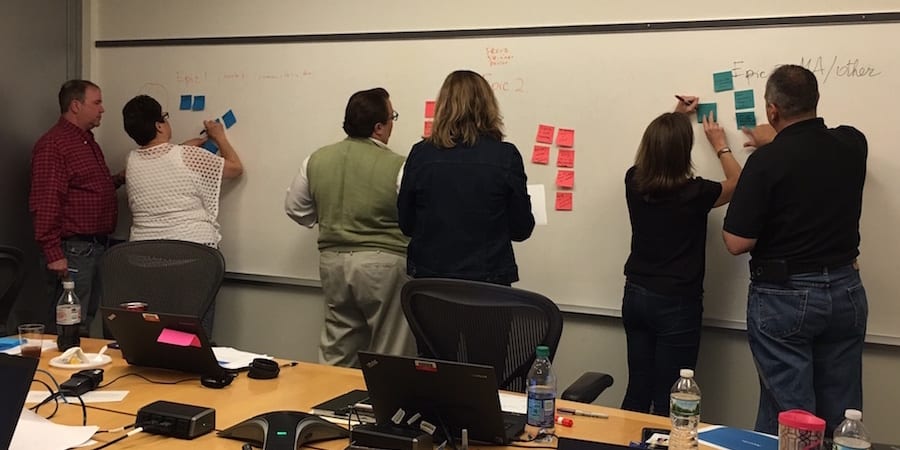
Taking lean improvement to heart
INTERVIEW – This cardiac laboratory in Singapore was targeting one improvement and ended up with something different, but equally impactful for its patient flow.
Interviewee: Chiong Siau Chien, Senior Manager of Cardiac Laboratory, National Heart Centre Singapore
Planet Lean: What led the National Heart Center Singapore (NHCS) to start a lean journey?
Chiong Siau Chien: Our main objective for joining the Lean Skills Development Program (LSDP) was to develop the internal capabilities of our organization. There had been experiments with kaizen workshops in the past, but this is the first structured program we embark on. In fact, we are the pilot site for public hospitals in Singapore, that participated in this program. The LSDP is provided by the Singapore Institute of Technology and delivered by the Lean Global Network (Denise Bennett was our coach) over the course of 10 months. It taught us the fundamental lean concepts and provided us with six weeks of precious coaching sessions with Denise.
PL: Can you tell us more about the problem you wanted to solve?
CSC: As a national referral center for the advanced cardiovascular medicine care in the country, our center has 9,000 admissions, receives 121,000 outpatient clinic visits, and performs 35,000 echocardiography scans annually. In our department, we have about 120 scans scheduled per day, although the maximum number of scans performed by our staff is only about 100, with an average of seven scans per staff per day (generally accepted, recommended number per staff). With such a high demand, it’s not surprising that our A3’s initial problem statement was the need to shorten the waiting time for the next available scan appointment. We have a long waiting time for test appointment, which is not acceptable to our patients (or us), even for an elective request. Hence, our goal was to work towards reducing it. Unfortunately, after 10 months of learning and coaching, we did not succeed, although we did learn a lot in the process.
PL: What did you learn, for example?
CSC: For the first time, we realized how much waste there was in the system! Our go see exercise unearthed some of the biggest problems we face. For instance, it is difficult for patients to find their way around our department, which of course causes delay. Our patient calling system did not perform well either, as patients often cannot see their queue numbers being called on the screen, which causes further delay. This often results in our assessment room staff having to physically walk to the common wait area to call for their patients. We also learned that room preparation for the echocardiography scans is highly variable – it usually takes 5-10 minutes, but that can increase to 25 minutes for complex cases. Moreover, in some instances, the scan rooms may be vacant for a long time (up to 30 mins) with no patients and yet we did not know why!
Thanks to the value stream map that we performed, we were able to identify two of our biggest pain points in the patient journey in our department: (1) an average wait of 10 minutes for an initial patient assessment, and (2) another 17 minutes average wait time for the actual scan.
It didn’t take long for us to realize that lean tools and practices are a great alternative to traditional operations, and we now have the opportunity to experiment these in our department.
PL: What countermeasures did you apply to these problems?
CSC: An important lesson that we learnt is that to manage any situation, we need to have the key information in a timely manner, so that actions can be taken promptly to rectify the problem. Indeed, lean has taught us how to visualize our productivity, monitor and review our performance together as a department, and we did all these daily. Before joining the LSDP, we had no system in place to record the daily work we performed, and none of the staff was aware of the amount of work they had done – not even myself (these numbers are only available to management two months later). Following suggestions from our staff, we introduced door tags and color-coded visual boards outside each scan room’s door: the work in each room is now recorded and summarized using a central board. Having the central visual board is fantastic, because it makes our activity visible and keeps us informed on the amount of work we have done, as a department.
We also introduced a new role – the “floor manager” – to manage and facilitate patient flow on a daily basis. The floor manager is also responsible for constantly summarizing the work done on the central visual board. Finally, we introduced a daily huddle that starts at 8.05 am promptly. We love the daily huddle as it is now the official channel of communication and serves to address quick fixes and disseminate information in a swift and effective manner. All these practices have definitely improved communication and allowed for better patient flow within the echo lab.

PL: How many people has lean reached inside the Cardiac Lab?
CSC: Almost everyone in the department to some extent. We engaged everyone from the very beginning, from cardiac (imaging) technologist to registration associates, nurses and our cardiologists. We all got involved, even though we didn’t know what we were doing at the beginning. We have learned throughout the journey, in big and small ways. In hindsight, being inclusive from day one was great, because it built trust among our staff and invited many good suggestions and fresh ideas along the way.
PL: What sort of results did the lean improvements bring to the Cardiac Lab?
CSC: Our project is ongoing, but there is no doubt it has been a very positive experience so far. Not only were we able to increase the utilization rate of the scan rooms in the first hour of the day, most importantly we reduced the waiting time for the scan on the day of the patient appointment by 57%! (The average wait time for the initial patient assessment was reduced from 10 to 3 minutes, while the average wait time for the actual scan dropped from 17 to 4 minutes.)
Interestingly, in the first three months of the implementation, we even saw an increase in work productivity. There is no doubt this resulted from our new way of working in the lab. The most impactful change that I believe can serve us well is the daily huddle, because it represents a true cultural change. Apart from information dissemination, I have used it many times myself, as a platform for sharing feedback, as well as encouraging positive values such as the importance of patient-oriented service.
We may not have achieved what we set out to achieve, but we have certainly benefited from lean in other ways, especially in terms of patient experience and the work culture in our department.
PL: What was it like to work with an external coach?
CSC: Our team, although from various background (from doctor to technologist to executives), is very task-oriented. So, as soon as Denise arrived, everyone started jumping to solutions, in an attempt to solve the problems. We made it quite hard for poor Denise! By the third coaching session, we realized the importance of observation and data collection to understand the problem, rather than providing quick solutions. We began to remind each other to “not jump into solutions” and we gradually changed our behavior as a group.
PL: How would you say you have changed as a leader?
CSC: I previously didn’t like to lead, even though I have to manage 100 staff. Now things are different for me. I have learned that people are our greatest asset and that it is important to actively engage with them and listen to their problems and suggestions on how they can improve the patient experience. I would then take a step back, allow time for the staff to work through their problem, and only when necessary step in to assist and direct them. This opportunity to embrace a different way of thinking and practice is very enjoyable and rewarding for me.
THE INTERVIEWEE

Read more



INTERVIEW – Business services company Dun & Bradstreet learned that the best way to tackle organizational challenges is using a combination of agile, lean startup and more traditional lean principles.


FEATURE – We tend to take the “goodness” of lean for granted, but – the author says – we should stop and think about what makes lean a good business practice. Why is it a way of thinking all businesses should adopt?


RESEARCH - Standard work is not meant for senior leadership, but there are activities that CEOs can carry out systematically to support a lean management system, starting from problem solving.


FEATURE – This article offers an exhaustive explanation of how to prepare a Concept Paper and why this is a tool that will help us to succeed in the execution of large change projects.

